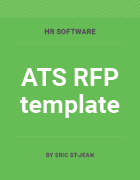
Getty Images
7 tips for writing an RFP for an ATS (with template)
Including information like budget in an RFP is important because it can help vendors decide if their application is a good fit. Learn more about an RFP for an ATS.
Acquiring new software like an applicant tracking system can be a risky experience that often leads to unmet requirements, cost overruns and missed timelines. A request for proposal can help avoid some of these challenges.
An applicant tracking system (ATS) can help simplify the recruiting process. However, talent acquisition leaders should make sure their company's search for a new ATS takes into account all of the organization's needs. A properly filled-out request for proposal (RFP) helps put vendors and their potential clients on the same page.
Learn more about how to write an RFP for an ATS.
What is an RFP?
An RFP is a document that lists a company's needs for a product or service. The document typically includes information about the company, the requirements for the product or service, project timeline, high-level budget information, contact information, rules that a vendor must follow when submitting a proposal, deadlines, and the process for evaluating the submissions.
RFPs are posted in the public domain, often via a service that hosts RFPs from various companies. Vendors monitor these sites for RFPs related to their product or service. Once the application deadline passes, the RFP is removed, and the company begins reviewing the submissions received.
The RFP process is intended to make the evaluation and selection free from bias. A talent acquisition leader interested in learning more about specific vendors could reach out and encourage them to respond to the company's RFP.
Alternatively, a talent acquisition leader or someone working on their behalf might try to identify potential vendors on their own, then approach them for more information and schedule demos. In this case, a company does not need to follow predetermined rules about the software selection.
7 tips for writing an RFP for an ATS
Including all the necessary information in an RFP can help avoid problems later. Learn some best practices for writing one for an ATS.
1. Describe the company
The document should explain what the company is, how long it has been in business, and where it operates.
Describing the company's locations is important because an organization operating in multiple countries will likely want to purchase software that can support multiple currencies and languages, as well as privacy laws for various countries.
2. Specify requirements and changes made
One of the key features of an RFP is the list of requirements.
The list of requirements should be thorough, and the person leading the requirements gathering for the ATS -- usually an employee who works in talent acquisition or IT -- should also consult with stakeholders to make sure everything is captured.
In addition, including a change log in the RFP document helps readers focus on the areas of the document that have changed instead of needing to reread the whole document each time a new revision is released.
3. Indicate the primary contact
The RFP should indicate the person vendors should contact with questions and how to do so.
The primary contact can record all the questions and share them with co-workers and other vendors, if needed. Having all vendors contact the same person also helps keep the process objective.
4. Share the budget
Including a high-level budget in an RFP is important because the budget can help vendors decide if their application is a good fit. Large ATS vendors might only want to be part of the RFP process if their customer is in their target market.
The talent acquisition leader will still have the opportunity to negotiate with the preferred vendor later in the process, so listing the budget in the RFP is primarily to give vendors a general idea of the target number.
5. Explain the RFP process and deadlines
The RFP should clearly outline the applicable deadlines for the application, evaluation and selection processes. The document should also explain the rules about the materials to include in a vendor submission.
If a vendor misses a deadline or does not respond with all the required information, their application might be rejected.
6. Describe the evaluation process
The RFP should describe the evaluation process and the associated timeline.
Describing the evaluation aims to keep the process transparent for all vendors and avoid bias, while prompting vendors to incorporate any helpful information in their submissions. It also sets expectations about what the vendors might have to do during the evaluation, such as providing one or more demonstrations of their application.
7. Educate the evaluation team
The team responsible for reviewing the RFP and taking part in the evaluation process should know what their role is during the evaluation process, what they are allowed to do, and what they should do when asked to do something beyond their area of responsibility.
For example, if a vendor approaches a member of the team with a question, the team member should tell the vendor to get in touch with the organization's primary contact.
Free template for an RFP for an ATS
This template can provide a good starting point for what to include in an RFP for an ATS.
Eric St-Jean is an independent consultant with a particular focus on HR technology, project management and Microsoft Excel training and automation. He writes about numerous business and technology areas.








